The Impact of Probability Density Functions Assessment on Model Performance for Slope Stability Analysis
Abstract
:1. Introduction
2. Materials and Methods
2.1. Physically Based Landslide Forecasting Model
- (1)
- On the safe side of the prediction, and without detailed characterization for the unsaturated parameters, the soil cover can be considered in fully saturated conditions; thus, the balance of mass for the pore water (dψ/dt = Dα d2ψ/dZ2, in which ψ is the pressure head linked to infiltration process, and Dα is the soil 1D consolidation coefficient) reduces to the simple diffusion;
- (2)
- Because γs is typically affected by low uncertainty, it can be considered constant and evaluated from the literature data;
- (3)
- If a high-resolution DTM is used, the slope steepness can be assumed accurate enough to be characterized by no uncertainty;
- (4)
- The water table depth should be monitored at different points of the study area.
- Soil mechanical properties (c’, φ’);
- Soil saturated hydraulic conductivity ks and soil stiffness Eed, both considered in the infiltration problem through the coefficient of consolidation, ;
- Thickness of the soil cover layer, h.
2.2. Study Area
2.3. Physical and Mechanical Properties
2.4. Rainfall Data
3. Results and Discussion
- -
- A decreasing trend with time of rainfall can be observed for gray classes: after 8 h of rainfall, the areas involved by PoFr < 15% are about 85%, and those by PoFu < 15% are about 70%, while after 32 h, gray PoFr classes reach 70%, and gray PoFu classes about 50%;
- -
- An increasing trend with time of rainfall can be observed for both beige (15% < PoF < 35%) and orange (35% < PoF < 50%) classes;
- -
- In the case of the more dangerous classes (red classes), it can be noticed that the red PoFr portions pass from about 5% (td = 8 h) to 8% (td = 32 h), while the red PoFu areas are negligible during all the duration of the rainfall (they reach about 1% at the end of the rainfall).
4. Conclusions
Author Contributions
Funding
Data Availability Statement
Conflicts of Interest
References
- Salciarini, D.; Brocca, L.; Camici, S.; Ciabatta, L.; Volpe, E.; Massini, R.; Tamagnini, C. Physically based approach for rainfall-induced landslide projections in a changing climate. Proc. Inst. Civ. Eng. Geotech. Eng. 2019, 172, 481–495. [Google Scholar] [CrossRef]
- Alvioli, M.; Melillo, M.; Guzzetti, F.; Rossi, M.; Palazzi, E.; von Hardenberg, J.; Brunetti, M.T.; Peruccacci, S. Implications of climate change on landslide hazard in Central Italy. Sci. Total Environ. 2018, 630, 1528–1543. [Google Scholar] [CrossRef]
- Ciabatta, L.; Camici, S.; Brocca, L.; Ponziani, F.; Stelluti, M.; Berni, N.; Moramarco, T. Assessing the impact of climate-change scenarios on landslide occurrence in Umbria Region, Italy. J. Hydrol. 2016, 541, 285–295. [Google Scholar] [CrossRef]
- Haque, U.; da Silva, P.F.; Devoli, G.; Pilz, J.; Zhao, B.; Khaloua, A.; Wilopo, W.; Andersen, P.; Lu, P.; Lee, J.; et al. The human cost of global warming: Deadly landslides and their triggers (1995–2014). Sci. Total Environ. 2019, 682, 673–684. [Google Scholar] [CrossRef]
- Gariano, S.L.; Melillo, M.; Peruccacci, S.; Brunetti, M.T. How much does the rainfall temporal resolution affect rainfall thresholds for landslide triggering? Nat. Hazards 2020, 100, 655–670. [Google Scholar] [CrossRef] [Green Version]
- Guzzetti, F.; Cardinali, M.; Reichenbach, P. The AVI project: A bibliographical and archive inventory of landslides and floods in Italy. Environ. Manag. 1994, 18, 623–633. [Google Scholar] [CrossRef]
- Guzzetti, F.; Tonelli, G. Information system on hydrological and geomorphological catastrophes in Itlay (SICI): A tool for managing landslide and flood hazards. Nat. Hazards Earth Syst. Sci. 2004, 4, 213–232. [Google Scholar] [CrossRef]
- Trigila, A.; Iadanza, C.; Spizzichino, D. Quality assessment of the Italian Landslide Inventory using GIS processing. Landslides 2010, 7, 455–470. [Google Scholar] [CrossRef]
- Peruccacci, S.; Brunetti, M.T.; Gariano, S.L.; Melillo, M.; Rossi, M.; Guzzetti, F. Rainfall thresholds for possible landslide occurrence in Italy. Geomorphology 2017, 290, 39–57. [Google Scholar] [CrossRef]
- Brunetti, M.T.; Luino, F.; Vennari, C.; Peruccacci, S.; Biddoccu, M.; Valigi, D.; Luciani, S.; Cirio, C.G.; Rossi, M.; Nigrelli, G.; et al. Rainfall Thresholds for Possible Occurrence of Shallow Landslides and Debris Flows in Italy. In Dating Torrential Processes on Fans and Cones. Advances in Global Change Research; Schneuwly-Bollschweiler, M., Stoffel, M., Rudolf-Miklau, F., Eds.; Springer: Dordrecht, The Netherlands, 2013; Volume 47. [Google Scholar] [CrossRef]
- Sestras, P.; Bilașco, Ș.; Roșca, S.; Dudic, B.; Hysa, A.; Spalević, V. Geodetic and UAV Monitoring in the Sustainable Management of Shallow Landslides and Erosion of a Susceptible Urban Environment. Remote Sens. 2021, 13, 385. [Google Scholar] [CrossRef]
- Zhang, L.; Wang, X.; Xia, T.; Yang, B.; Yu, B. Deformation Characteristics of Tianjiaba Landslide Induced by Surcharge. ISPRS Int. J. Geo-Inf. 2021, 10, 221. [Google Scholar] [CrossRef]
- Aleotti, P.; Chowdhury, R. Landslide hazard assessment: Summary review and new perspectives. Bull. Int. Assoc. Eng. Geol. 1999, 58, 21–44. [Google Scholar] [CrossRef]
- Guzzetti, F.; Carrara, A.; Cardinali, M.; Reichenbach, P. Landslide hazard evaluation: A review of current techniques and their application in a multi-scale study, Central Italy. Geomorphology 1999, 31, 181–216. [Google Scholar] [CrossRef]
- Brabb, E. Innovative Approaches for Landslide Hazard Evaluation. IV Int. Symp. Landslides 1984, 1, 307–323. [Google Scholar]
- Gariano, S.L.; Guzzetti, F. Landslides in a changing climate. Earth-Sci. Rev. 2016, 162, 227–252. [Google Scholar] [CrossRef] [Green Version]
- Srivastava, R.; Yeh, T.-C.J. Analytical solutions for one-dimensional, transient infiltration toward the water table in homogeneous and layered soils. Water Resour. Res. 1991, 27, 753–762. [Google Scholar] [CrossRef]
- Conte, E.; Troncone, A. A method for the analysis of soil slips triggered by rainfall. Géotechnique 2012, 62, 187–192. [Google Scholar] [CrossRef]
- Zhang, J.; Zhu, D.; Zhang, S. Shallow slope stability evolution during rainwater infiltration considering soil cracking state. Comput. Geotech. 2020, 117, 103285. [Google Scholar] [CrossRef]
- Xu, J.; Zhao, X.; Li, P.; Zhang, M. Stability of a 3D unsaturated vertical cut slope subjected to variable rainfall infiltration. Comput. Geotech. 2021, 134, 104110. [Google Scholar] [CrossRef]
- Montgomery, D.R.; Dietrich, W.E. A physically based model for the topographic control on shallow landsliding. Water Resour. Res. 1994, 30, 1153–1171. [Google Scholar] [CrossRef]
- Wu, W.; Sidle, R.C. A Distributed Slope Stability Model for Steep Forested Basins. Water Resour. Res. 1995, 31, 2097–2110. [Google Scholar] [CrossRef]
- Iverson, R.M. Landslide triggering by rain infiltration. Water Resour. 2000, 36, 1897–1910. [Google Scholar] [CrossRef] [Green Version]
- Jibson, R.W.; Harp, E.L.; A Michael, J. A method for producing digital probabilistic seismic landslide hazard maps. Eng. Geol. 2000, 58, 271–289. [Google Scholar] [CrossRef]
- Baum, R.L.; Savage, W.Z.; Godt, J.W. TRIGRS—A FORTRAN program for transient rainfall infiltration and grid-based regional slope stability analysis. US Geol. Surv. Open File Rep. 2002, 424, 38. [Google Scholar]
- Baum, R.L.; Savage, W.Z.; Godt, J.W. TRIGRS—A FORTRAN Program for Transient Rainfall Infiltration and Grid-Based Regional Slope-Stability Analysis, Version 2.0 U.S. Geological Survey Open-File Report 2008-1159. Available online: https://pubs.usgs.gov/of/2008/1159 (accessed on 21 July 2008).
- Frattini, P.; Crosta, G.B.; Fusi, N.; Negro, P.D. Shallow landslides in pyroclastic soils: A distributed modelling approach for hazard assessment. Eng. Geol. 2004, 73, 277–295. [Google Scholar] [CrossRef]
- Salciarini, D.; Volpe, E.; Kelley, S.A.; Brocca, L.; Camici, S.; Fanelli, G.; Tamagnini, C. Modeling the Effects Induced by the Expected Climatic Trends on Landslide Activity at Large Scale. Procedia Eng. 2016, 158, 541–545. [Google Scholar] [CrossRef] [Green Version]
- Salciarini, D.; Tamagnini, C.; Conversini, P.; Rapinesi, S. Spatially distributed rainfall thresholds for the initiation of shallow landslides. Nat. Hazards 2011, 61, 229–245. [Google Scholar] [CrossRef]
- Salciarini, D.; Tamagnini, C.; Ponziani, F.; Berni, N. Defining Physically-Based Rainfall Thresholds for Early Warning Systems. Landslide Sci. Pract. 2013, 1, 651–657. [Google Scholar]
- Schilirò, L.; Cepeda, J.; Devoli, G.; Piciullo, L. Regional Analyses of Rainfall-Induced Landslide Initiation in Upper Gudbrandsdalen (South-Eastern Norway) Using TRIGRS Model. Geoscience 2021, 11, 35. [Google Scholar] [CrossRef]
- Lind, N. Modelling of uncertainty in discrete dynamical systems. Appl. Math. Model. 1983, 7, 146–152. [Google Scholar] [CrossRef]
- Godt, J.; Baum, R.; Savage, W.; Salciarini, D.; Schulz, W.; Harp, E. Transient deterministic shallow landslide modeling: Requirements for susceptibility and hazard assessments in a GIS framework. Eng. Geol. 2008, 102, 214–226. [Google Scholar] [CrossRef]
- Fenton, G.A.; Griffiths, D.V. Risk Assessment in Geotechnical Engineering; Wiley: New York, NY, USA, 2008. [Google Scholar]
- Lacasse, S.; Nadim, F. Uncertainties in Characterizing Soil Properties. In Proc. ASCE Special Technical Publication 58: Uncertainty in the Geologic Environment—From Theory to Practice; Pacific Earthquake Engineering Research Center (PEER): Richmond, CA, USA, 1996. [Google Scholar]
- Calvello, M. Dispense del Corso di Frane e Stabilità dei pendii. Personal communication, 2012. [Google Scholar]
- Caira, M.; Carcassi, M.; Carpignano, A.; Castiglia, F.; Zio, E. Le Incertezze Nelle Analisi di Rischio. Rapp. Tecn. Available online. IHMC Cmap-Tools 2006-01, Florida Institute for Human e Machine Cognition. 2006. Available online: http://conference.ing.unipi.it/vgr2006/archivio/Articoli/285.pdf (accessed on 30 July 2021).
- Baecher, G.B.; Christian, J.T. Reliability and Statistics in Geotechnical Engineering; John Wiley & Sons: Hoboken, NJ, USA, 2005. [Google Scholar]
- Montrasio, L.; Valentino, R. A model for triggering mechanisms of shallow landslides. Nat. Hazards Earth Syst. Sci. 2008, 8, 1149–1159. [Google Scholar] [CrossRef]
- Cascini, L.; Cuomo, S.; Pastor, M.; Sorbino, G. Modeling of Rainfall-Induced Shallow Landslides of the Flow-Type. J. Geotech. Geoenviron. Eng. 2010, 136, 85–98. [Google Scholar] [CrossRef]
- Crosta, G.B.; Frattini, P. Distributed modelling of shallow landslides triggered by intense rainfall. Nat. Hazards Earth Syst. Sci. 2003, 3, 81–93. [Google Scholar] [CrossRef] [Green Version]
- Salciarini, D.; Godt, J.W.; Savage, W.Z.; Conversini, P.; Baum, R.L.; Michael, J.A. Modeling regional infiltration of rainfall induced shallow landslides in the eastern Umbria region of central Italy. Landslides 2006, 3, 181–194. [Google Scholar] [CrossRef]
- Salciarini, D.; Godt, J.; Savage, W.Z.; Baum, R.; Conversini, P. Modeling landslide recurrence in Seattle, Washington, USA. Eng. Geol. 2008, 102, 227–237. [Google Scholar] [CrossRef]
- Cascini, L.; Calvello, M.; Grimaldi, G.M. Groundwater Modeling for the Analysis of Active Slow-Moving Landslides. J. Geotech. Geoenviron. Eng. 2010, 136, 1220–1230. [Google Scholar] [CrossRef]
- Salciarini, D.; Volpe, E.; Cattoni, E. Probabilistic vs. Deterministic Approach in Landslide Triggering Prediction at Large–scale. In Geotechnical Research for Land Protection and Development; Part of the Lecture Notes in Civil Engineering Book Series (LNCE, Volume 40); Springer International Publishing: Cham, Switzerland, 2020; pp. 62–70. [Google Scholar]
- Nadim, F. Tools and Strategies for Dealing with Uncertainty in Geotechnics; Springer: Berlin/Heidelberg, Germany, 2007; Volume 491, pp. 71–95. [Google Scholar]
- Harr, M.E. Reliability-Based Design in Civil Engineering; Dover Publications, Department of Civil Engineering, School of Engineering, North Carolina State University: Raleigh, NC, USA, 1984. [Google Scholar]
- Papaioannou, I.; Straub, D. Reliability updating in geotechnical engineering including spatial variability of soil. Comput. Geotech. 2012, 42, 44–51. [Google Scholar] [CrossRef] [Green Version]
- Park, H.J.; Lee, J.H.; Woo, I. Assessment of rainfall-induced shallow landslide susceptibility using a GIS-based probabilistic approach. Eng. Geol. 2013, 161, 1–15. [Google Scholar] [CrossRef]
- Raia, S.; Alvioli, M.; Rossi, M.; Baum, R.L.; Godt, J.W.; Guzzetti, F. Improving predictive power of physically based rainfall-induced shallow landslide models: A probabilistic approach. Geosci. Model. Dev. 2014, 7, 495–514. [Google Scholar] [CrossRef] [Green Version]
- Salciarini, D.; Fanelli, G.; Tamagnini, C. A probabilistic model for rainfall—Induced shallow landslide prediction at the regional scale. Landslides 2017, 14, 1731–1746. [Google Scholar] [CrossRef]
- Fanelli, G.; Salciarini, D.; Tamagnini, C. Reliable soil property maps over large areas: A case study in central Italy. Environ. Eng. Geosci. 2016, 22, 37–52. [Google Scholar] [CrossRef]
- Salciarini, D.; Tamagnini, C.; Ronchi, F.; Volpe, E.; Fanelli, G. An approach for large-scale soil characterization for the application of non-structural landslide risk mitigation. Riv. Ital. Ing. Geotec. 2017, 51, 7–21. [Google Scholar]
- Regione Umbria. Italian Report: Analisi del Dissesto in Umbria ed Eventi di Frana del Novembre, Umbria Region Report n.1. 2005. Available online: https://www.isprambiente.gov.it/it (accessed on 30 July 2021).
- Borrelli, L.; Ciurleo, M.; Gullà, G. Shallow landslide susceptibility assessment in granitic rocks using GIS-based statistical methods: The contribution of the weathering grade map. Landslides 2018, 15, 1127–1142. [Google Scholar] [CrossRef]
- Ciurleo, M.; Cascini, L.; Calvello, M. A comparison of statistical and deterministic methods for shallow landslide susceptibility zoning in clayey soils. Eng. Geol. 2017, 223, 71–81. [Google Scholar] [CrossRef]
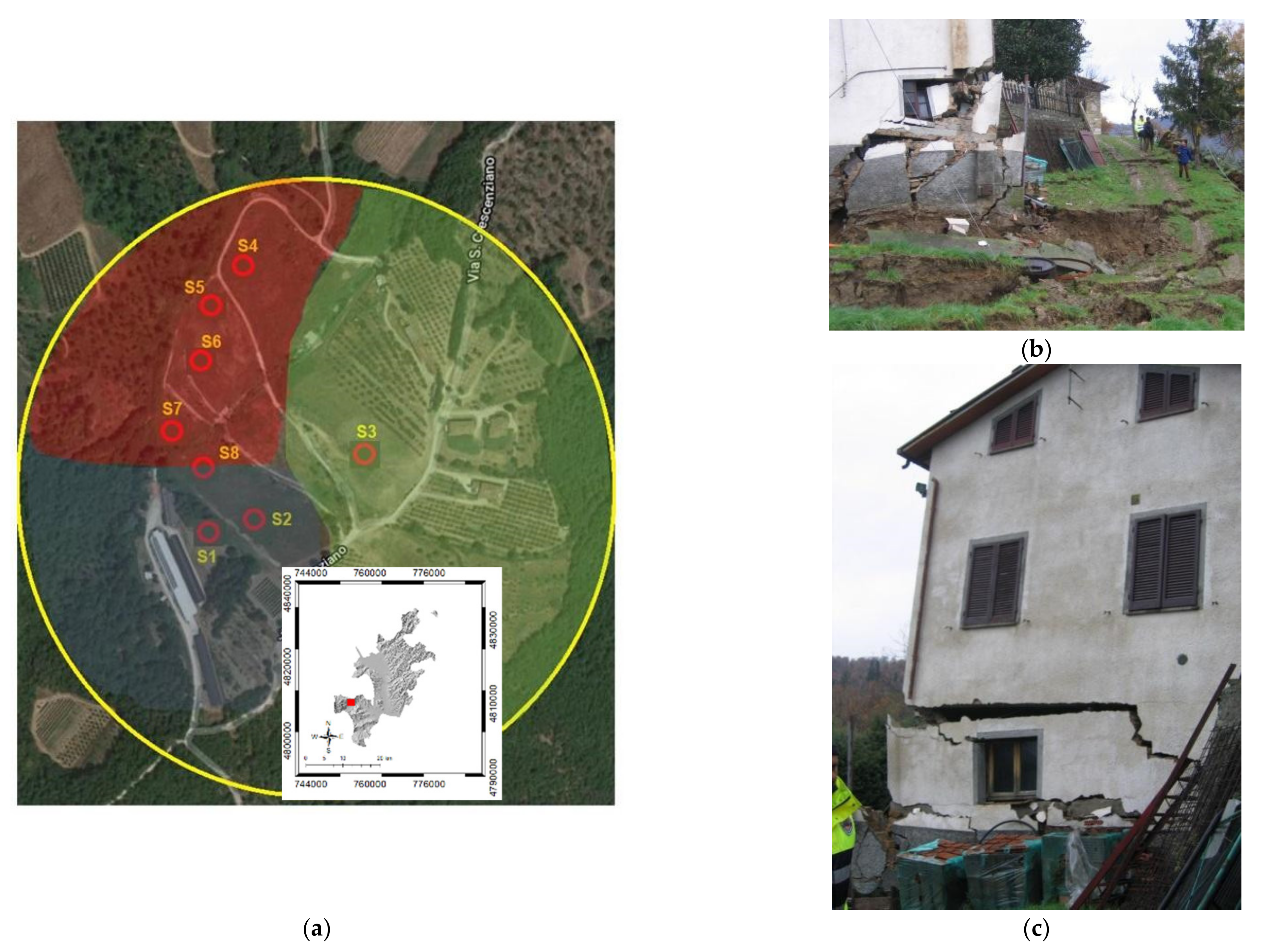

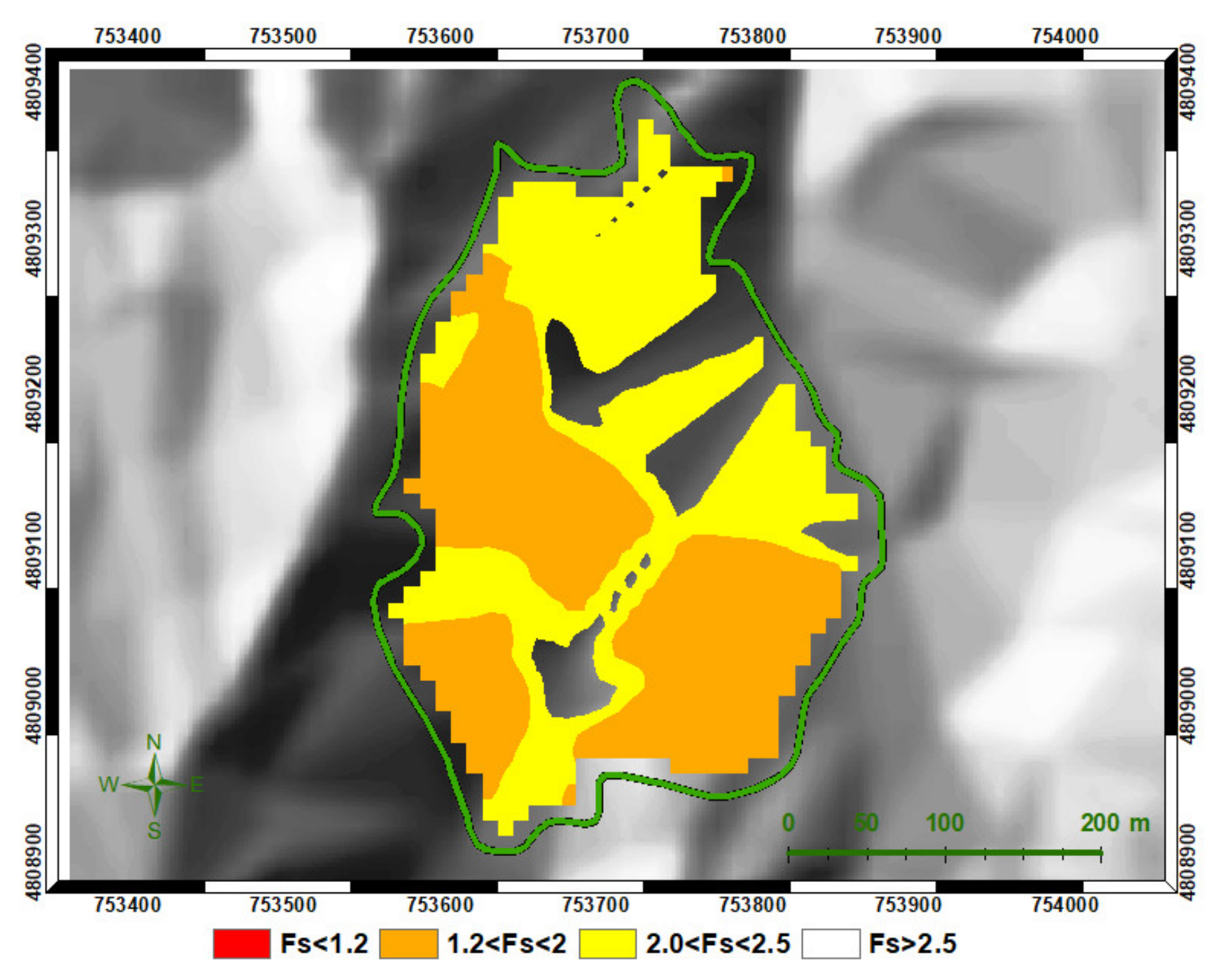
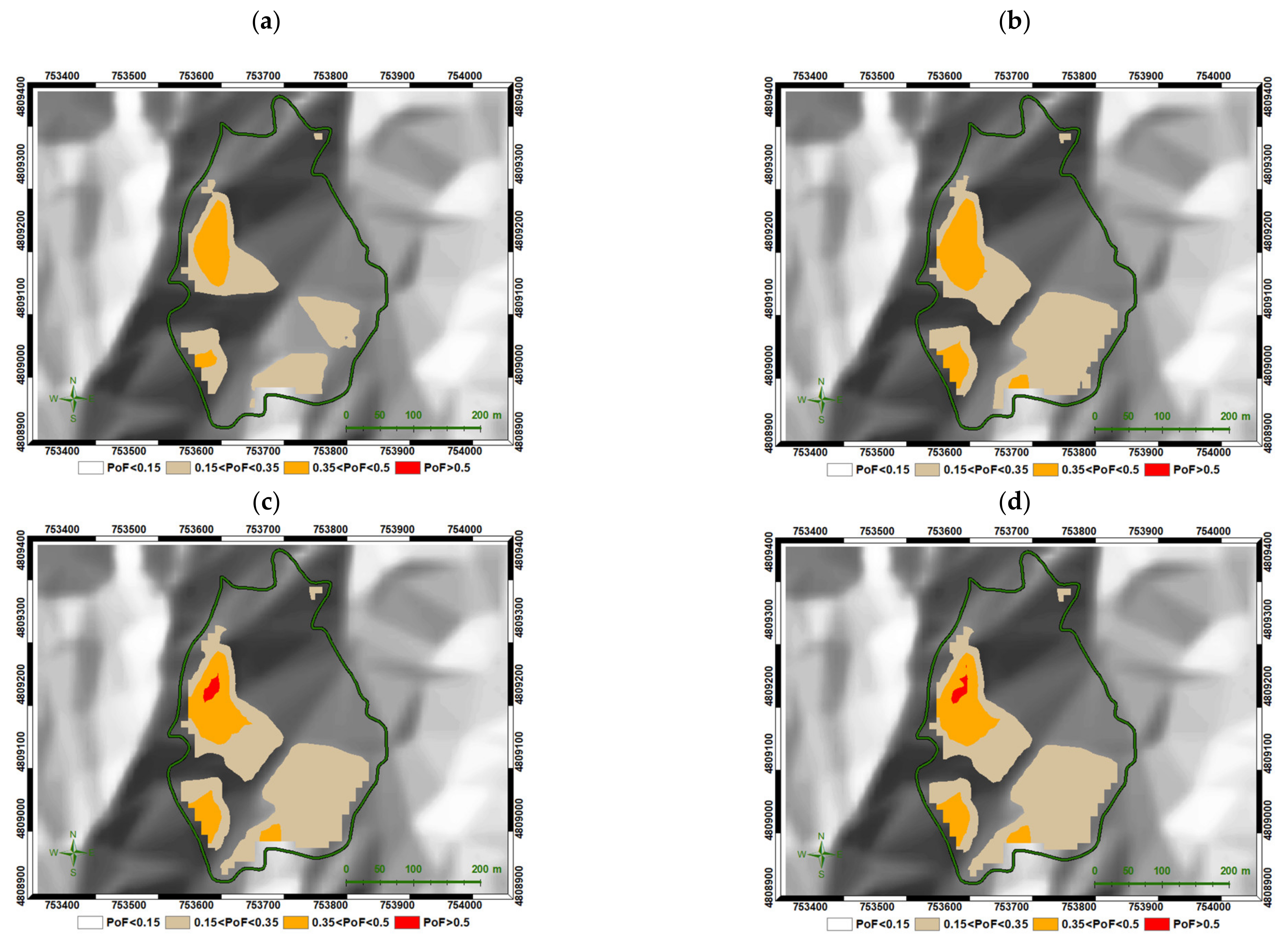
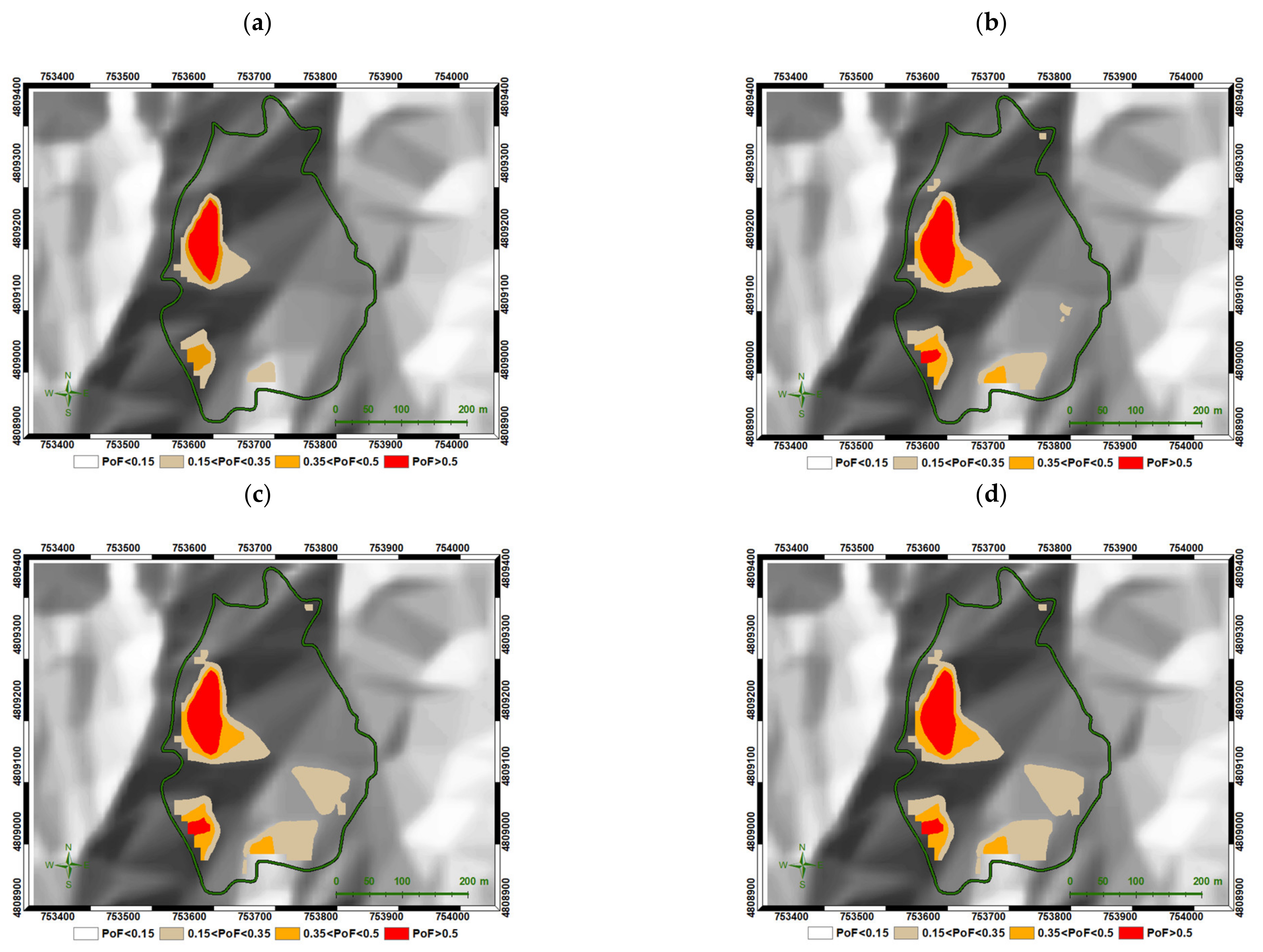
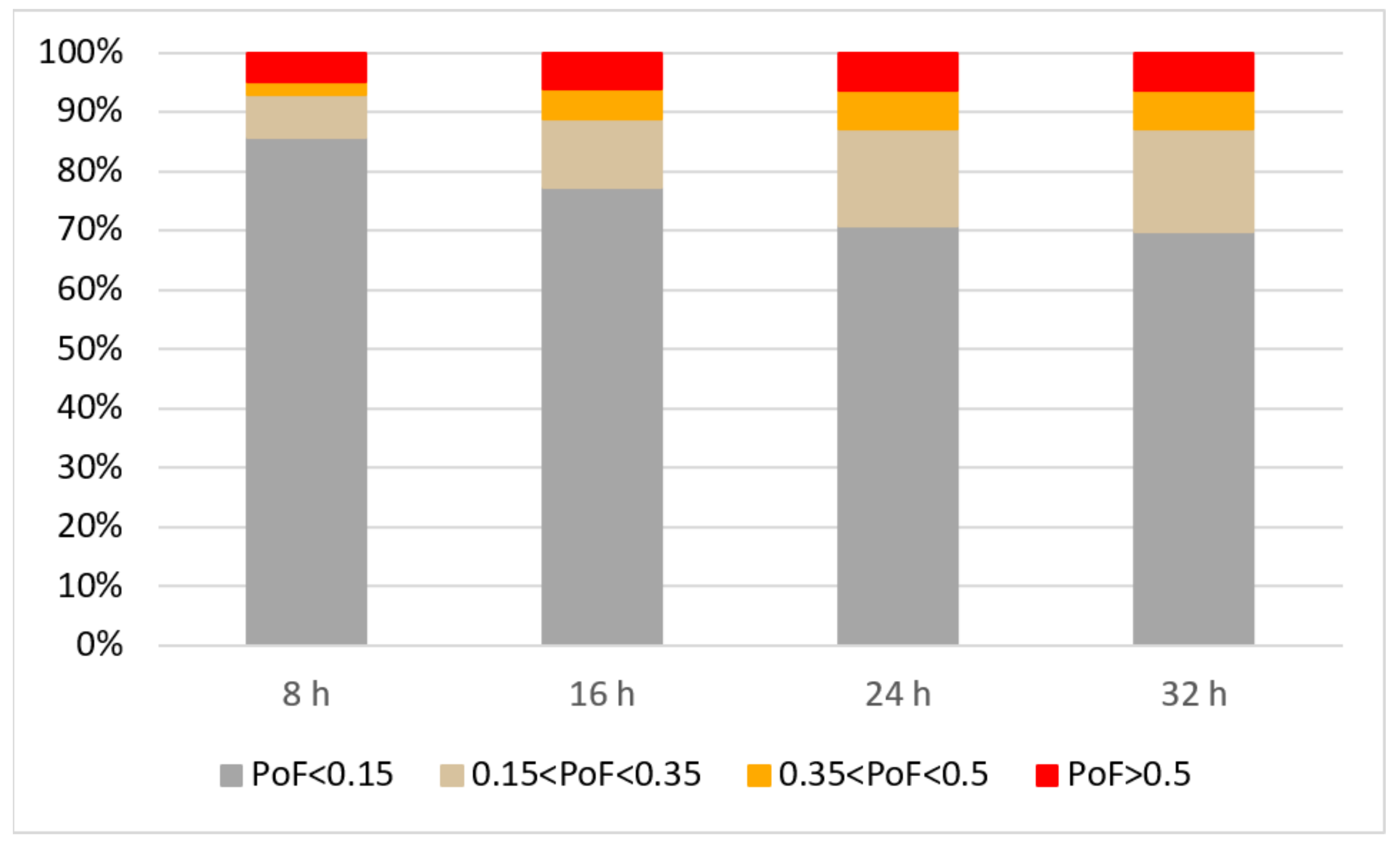
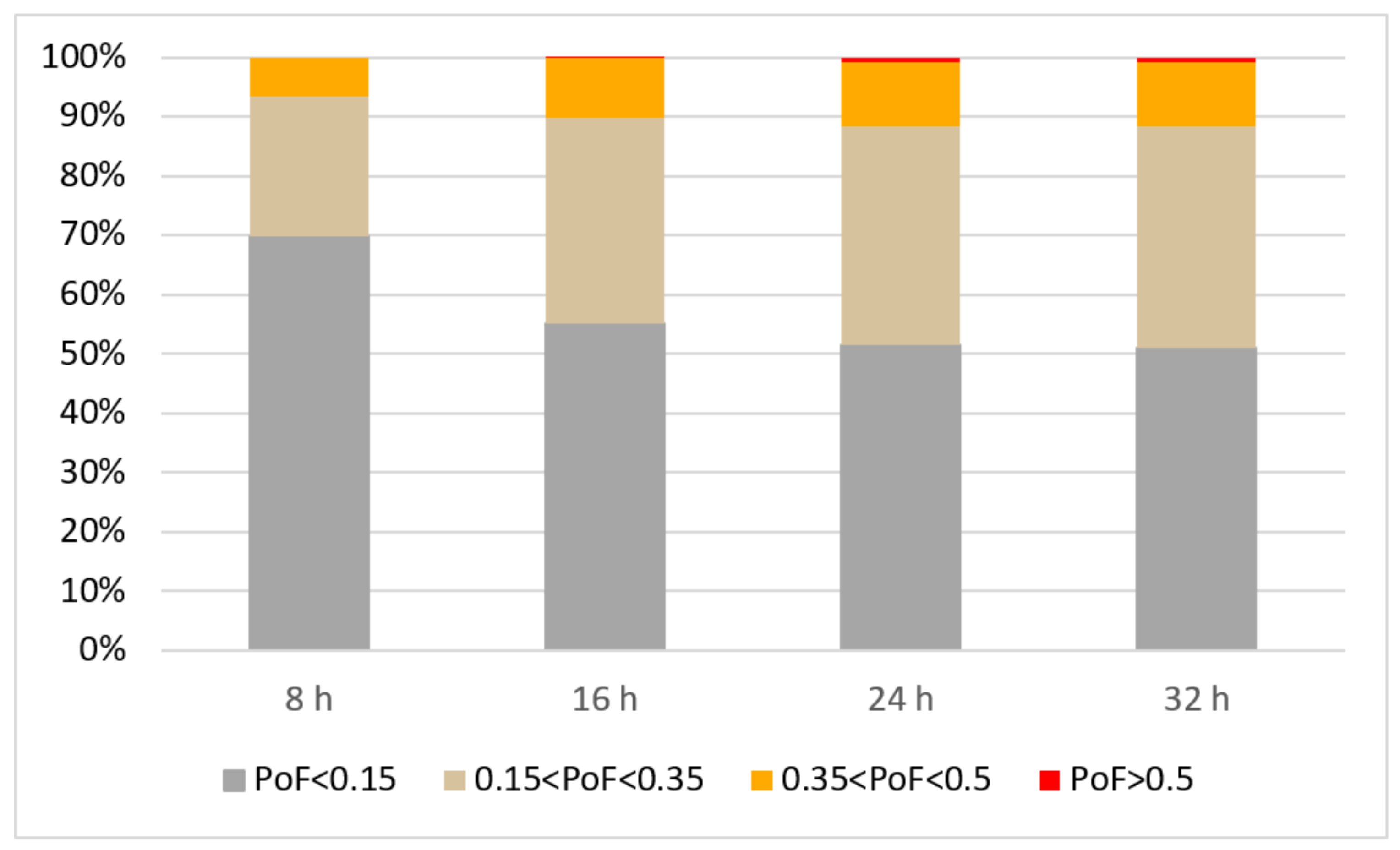
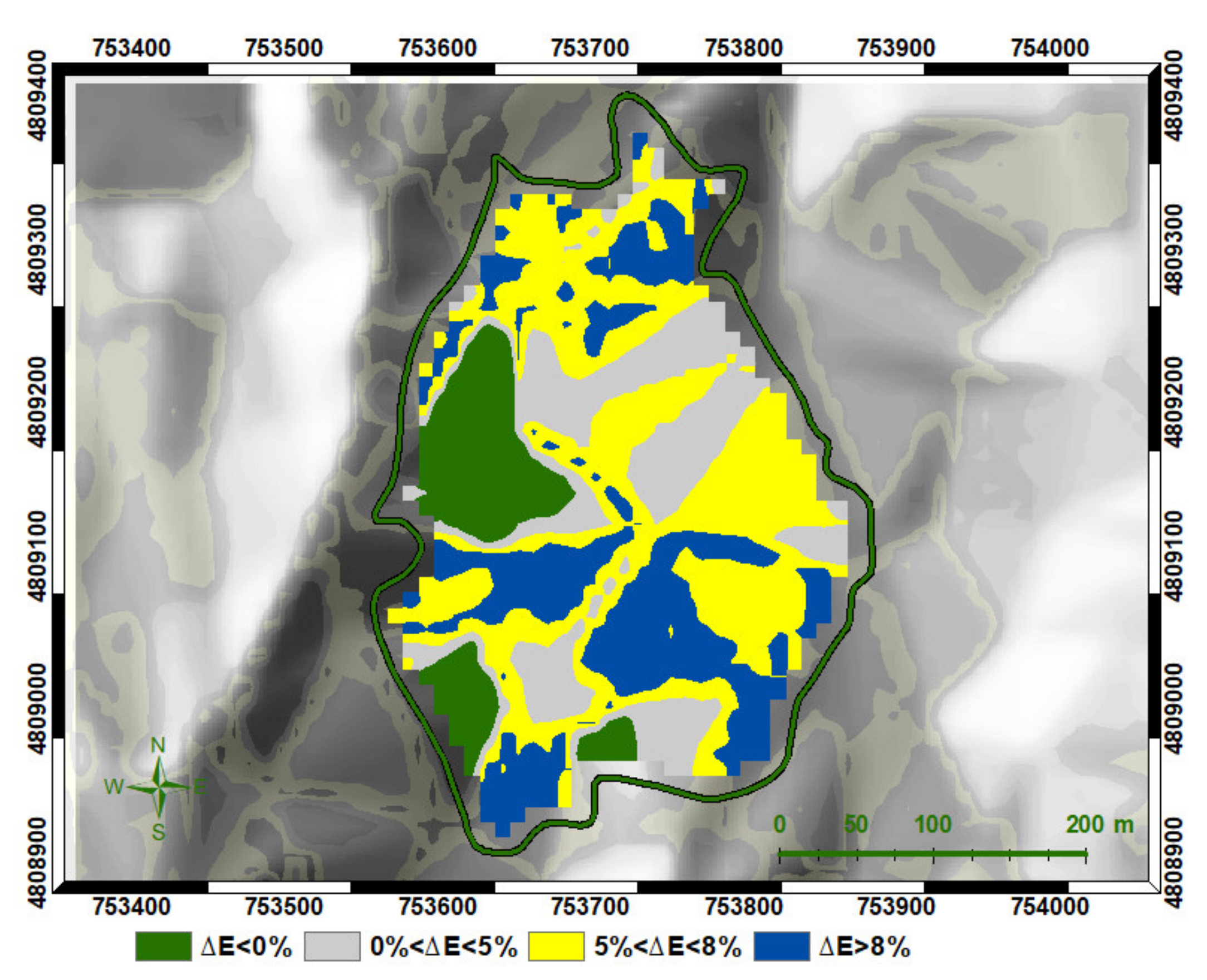
| Random Variable | Symbol | Unit | Mean | COV | |
|---|---|---|---|---|---|
| Effective friction angle | φ′ | (deg) | Normal | 30 | 0.20 |
| Effective cohesion | c | (kPa) | Log-normal | 5 | 0.25 |
| Saturated hydraulic conductivity | ks | (m/s) | Log-normal | 5 × 10−7 | 1 |
| Oedometric modulus | Eed | (kPa) | Beta | 1 × 10−4 | 0.18 |
| Thickness of the soil cover | h | (m) | Normal | 14exp(−0.07∗α) | 0.20 |
Publisher’s Note: MDPI stays neutral with regard to jurisdictional claims in published maps and institutional affiliations. |
© 2021 by the authors. Licensee MDPI, Basel, Switzerland. This article is an open access article distributed under the terms and conditions of the Creative Commons Attribution (CC BY) license (https://creativecommons.org/licenses/by/4.0/).
Share and Cite
Volpe, E.; Ciabatta, L.; Salciarini, D.; Camici, S.; Cattoni, E.; Brocca, L. The Impact of Probability Density Functions Assessment on Model Performance for Slope Stability Analysis. Geosciences 2021, 11, 322. https://doi.org/10.3390/geosciences11080322
Volpe E, Ciabatta L, Salciarini D, Camici S, Cattoni E, Brocca L. The Impact of Probability Density Functions Assessment on Model Performance for Slope Stability Analysis. Geosciences. 2021; 11(8):322. https://doi.org/10.3390/geosciences11080322
Chicago/Turabian StyleVolpe, Evelina, Luca Ciabatta, Diana Salciarini, Stefania Camici, Elisabetta Cattoni, and Luca Brocca. 2021. "The Impact of Probability Density Functions Assessment on Model Performance for Slope Stability Analysis" Geosciences 11, no. 8: 322. https://doi.org/10.3390/geosciences11080322







